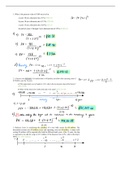1. When glucose is broken down via glycolysis, what molecule is created that could also be
oxidized under aerobic conditions?
i. Pyruvate
2. What is the best definition of complex carbohydrates?
i. Carbohydrates that are comprised of polysaccharides and that contain both
fiber and starch
3. Which regions of the spine demonstrate kyphotic curves?
i. Thoracic and Sacral
4. What are common physical characteristics of those with emphysema?
i. Those with emphysema are frequently underweight and may exhibit
hypertrophied neck muscles.
5. Which term best describes motion at the joint surface?
i. Arthrokinematics
6. Which of the following statements pertaining to high-intensity interval training (HIIT) is
incorrect?
i. Measuring intensity by one's "effort" (a subjective measure) is an accurate
measure of intensity.
7. Which mechanoreceptor is sensitive to changes in muscular tension and rate of that tension
change, causing the muscle to relax, which prevents the muscle from excessive stress and
possible injury?
i. Golgi Tendon Organs
8. What are the two components of the central nervous system?
i. The brain and the spinal cord
9. What principle describes the nervous system's ability to recruit the correct muscles to perform
movement?
i. Neuromuscular efficiency
10. What is best defined as the action of expanding the diameter of a blood vessel near the
surface of the skin, which helps remove heat from the body?
i. peripheral vasodilation
11. During which Phase of OPT should the exerciser be most concerned with increasing the speed
(repetition tempo) of exercises?
i. Phase 5 Power
12. Why does a shorter amortization phase lead to more effective plyometric movement?
i. It causes stored elastic energy to be used more efficiently
13. What is the definition of kinesiophobia?
i. Fear of movement
14. Which muscles may be overactive with knee valgus during the single-leg squat?
i. Adductor Complex
15. Which of the following is a characteristic of linear periodization?
i. Increases intensity while decreasing volume
16. Which of the following modalities is the least likely to increase joint instability?
, i. Strength machines
17. Which governmental agency regulates dietary supplements in Australia?
i. Therapeutic Good Administration TGA
18. The process of diffusion of oxygen and carbon dioxide gases in and out of the bloodstream
occurs in what structure or structures?
i. Alveolar sacs
19. The hamstring complex compensating for weakened hip extensors, which cannot produce
force effectively, is an example of what key term?
i. Synergistic dominance
20. Which of the following is unique to type 2 diabetes?
i. Insulin resistance
21. Clients with chronic lung disease often have shortness of breath, also known as which of the
following?
i. Dyspnea
22. Which type of muscle contraction/action attenuates force through muscle fiber lengthening?
i. Eccentric action
23. What structure in the heart transfers the electrical signal from the sinoatrial (SA) node to the
atrioventricular (AV) node?
i. Internodal pathway
24. Which of the following hormones, if increased at baseline, may be indicative of overtraining?
i. Cortisol
25. Which surface would be the most challenging for a new client starting a balance training
program?
i. BOSU ball
26. Which muscle is classified as a local muscle involved in stabilizing the spine?
i. Kettlebell RDL
27. WHich of the following is a behavior change technique where clients list potential barriers and
make plans to overcome them?
i. Coping responses
28. What is the Tanaka formula, which is used to estimate an individual's maximal heart rate?
i. 208-(0.7 x age)
29. The deep longitudinal subsystem includes which of the following muscle groups?
i. Hamstrings and erector spinae
30. The standard Jackson and Pollock 3-Site protocol for women requires skinfold measurements
at which of the following sites?
i. Suprailiac, thigh, and triceps
31. Which of the following is true about the biologically active forms of vitamins?
i. Biologically active forms are most effective for augmenting body levels.
32. Which of the following protein structures is important for muscular contractions by providing a
binding site?
i. Troponin
33. Which muscles are typically underactive in association with upper crossed syndrome?
i. Lower trapezius









